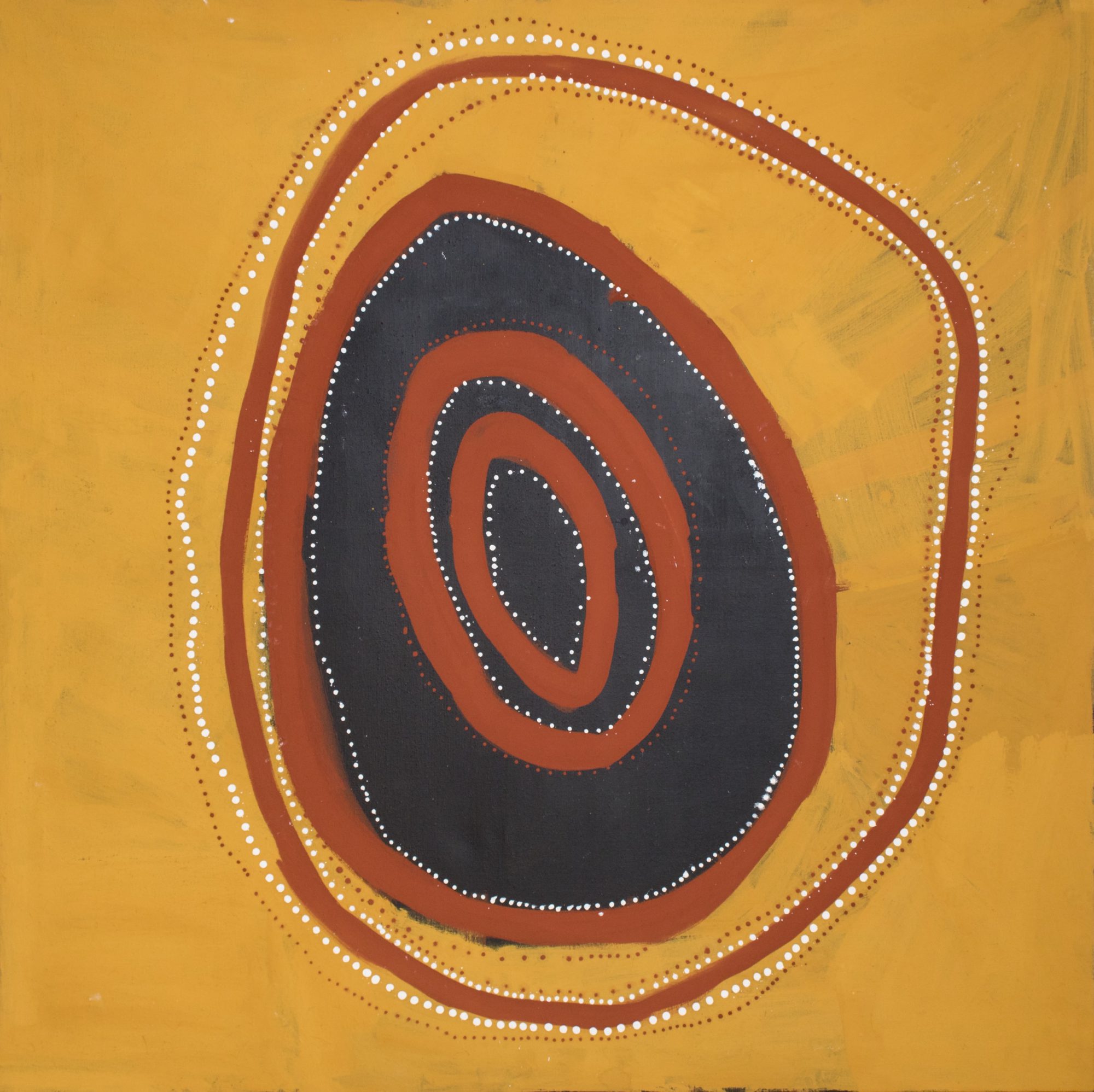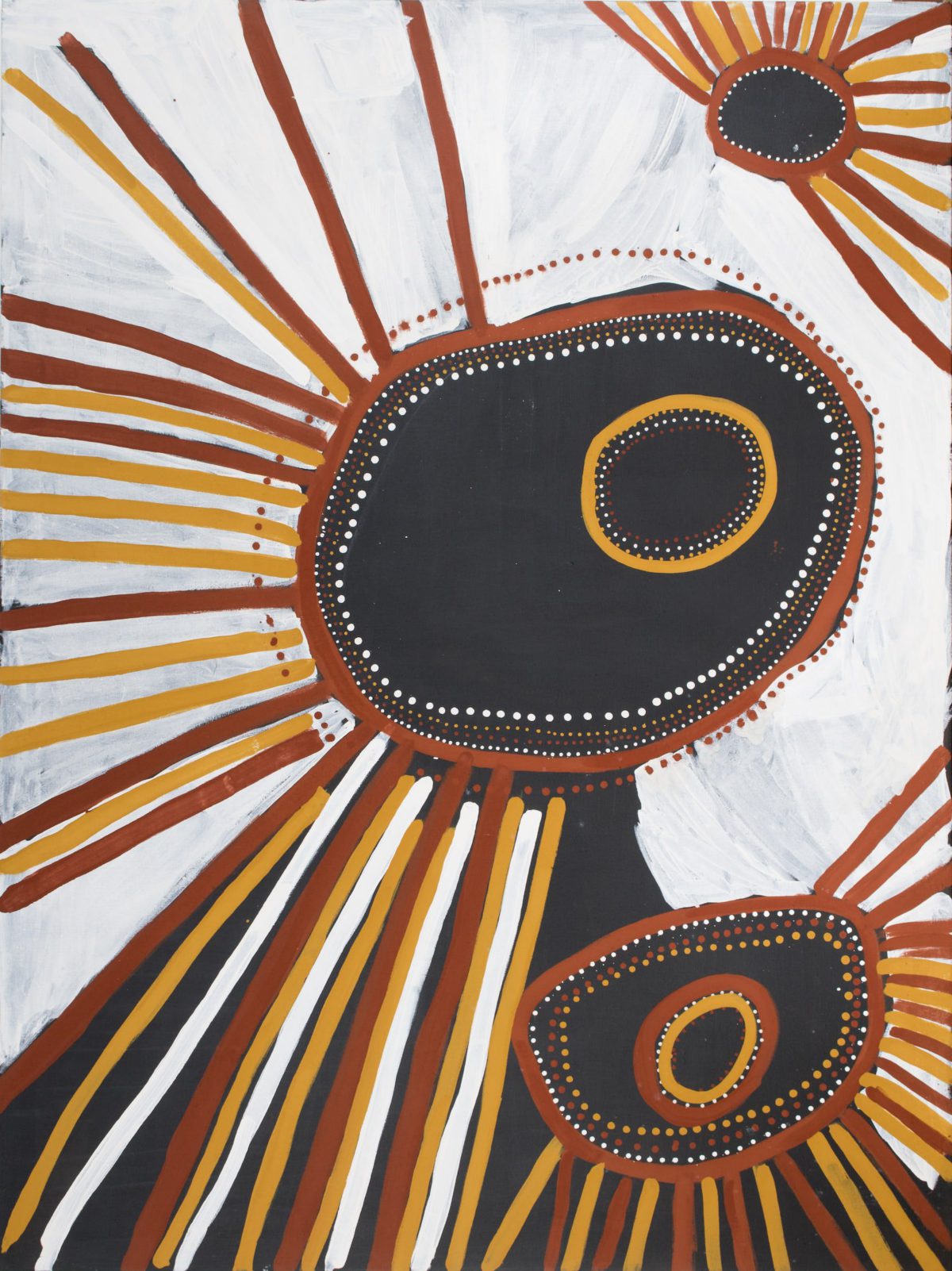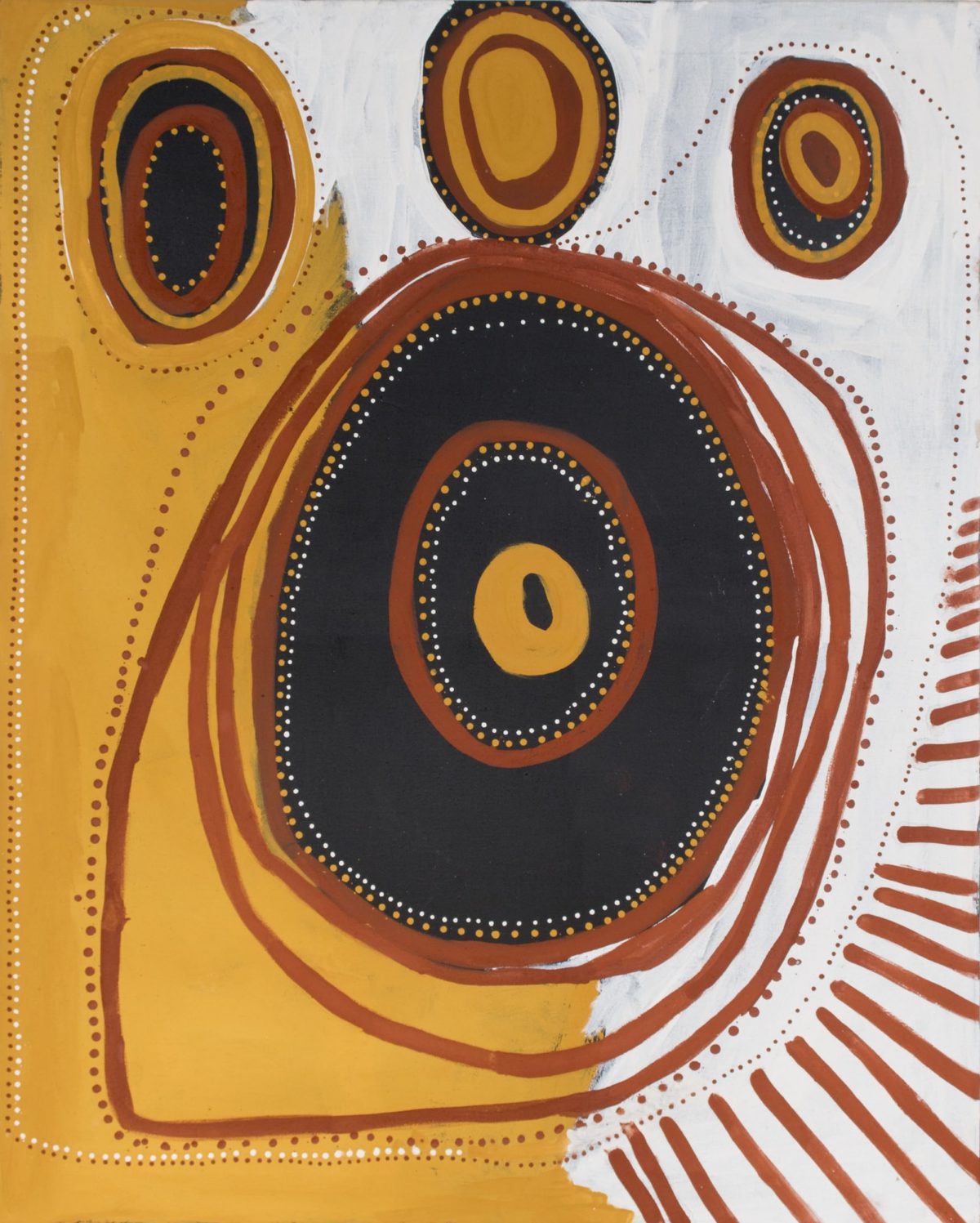
Warnarringa Jilamara — Painting Under The Tiwi Sun — Exhibition Essay

This painting is Warnarringa – that is the sun in Tiwi. In Tiwi the red ochre is yellow that we burn on the fire – it is the colour of the sun. Murtankala is our creation story – that old lady came up when it was all dark and she made light with yikwani (fire) and it became the sun.”
— Dino Wilson
Dino Wilson is a proud Tiwi man who lives in Milikapiti, Melville Island where he currently works at Jilamara Arts and Crafts Association. Born in 1983, his Country is Wurrumiyanga. His skin group Takaringuwi (Scaly Mullet). His dance Jarrangini (Buffalo).
The scale and confidence of Dino Wilson’s compositions in Warnarringa Jilamara – painting under the Tiwi sun, belie the fact that he has only been painting since 2017, after relocating to Milikapiti from Wurrumiyanga, Bathurst Island in 2016. Warnarringa Jilamara – painting under the Tiwi sun is Wilson’s second solo exhibition with Vivien Anderson Gallery, Naarm/Melbourne. The thirteen paintings in this exhibition were produced in 2021 and present four of Wilson’s favourite subjects: Ngiya Murrakupupuni (my Country), jaliwaki (bush potato), tunga (bark bag) and warnarringa (sun). Each painting in the exhibition demonstrates Wilson’s increasing mastery over large format painting and his ability to produce works of art at a scale that captures the vastness demanded by one of his most dynamic and represented subjects – warnarringa (sun).
The sun is very important to the Tiwi people. In Parlingarri (creation time) it is believed that the whole world was in perpetual darkness and inhabited by yamparriparri (evil spirits). The wulimaka (old lady) Murtankala came up from underground with three children in a tunga (bark bag) on her back. As she moved around on the surface, she created grooves and crevices in the land with her body. Some of these filled with water and created the geographical shapes and channels of the Tiwi Islands. She made yikwani (fire) by rubbing grass and sticks together and lifted it up into the sky with her two hands to create light for her children, one of whom was Purukuparli (the first Tiwi man). This light became warnarringa (the sun).”
— Jilamara Arts & Crafts Association
To this day contemporary Jilamara artists still use natural earth pigments from Country to paint. The yellow ochre is burnt on the fire to make the red pigment – the colours of the land, the sun and fire applied to recall the old designs and creation stories of the Tiwi people.”
— Jilamara Arts & Crafts Association

In November 2019, I visited Milikapiti, Melville Island, where I was immediately made aware of the unavoidable presence and power of the sun, its heat both showering from above and radiating off the surface of the earth. Heat felt from the ground up. During this visit I met Dino Wilson, his commanding presence akin to his paintings, full of personality and radiating warmth. Eager to have a chat and show me what he was working on, we wandered around to see the large Jaliwaki (Bush Potato) painting he was completing for his debut solo exhibition at Outstation Gallery, Darwin.
The fact that Dino Wilson has only been painting for the past five years needs to be contextualised within the continuous tradition of painting with natural earth pigments synonymous with Tiwi culture. Painting is an essential form of cultural expression in Tiwi ceremonial practice, along with kawakawayi (song) and yoyi (dance), and other forms of material production such as carving, weaving and making ceremonial ornaments.
Dino Wilson has previously acknowledged the ‘old people’ as an ongoing influence in his work, but also refers to contemporary life on the Tiwi Islands as an ongoing source of inspiration. His paintings are uniquely Tiwi. They celebrate the individual creativity of the artist. They demonstrate the harmonious coexistence of contemporary experience and continuous cultural tradition, testament to the powerful endurance of Tiwi aesthetics, iconography and storytelling.
Dino Wilson is among the next generation of contemporary artists working at Jilamara Arts and Crafts Association. His practice reflects the undeniable influence of more senior artists currently working at the art centre, particularly Conrad Tipungwuti (b.1966) and Timothy Cook (b.1958), both of whom have been painting at Jilamara since 1996. During a recent phone conversation Wilson mentioned, with admiration, Cook’s success and recent exhibition in Germany as a source of inspiration.
Dino Wilson paints alongside (metres from) Timothy Cook at the art centre. Cook’s works are also influenced by the paintings of the great Tiwi ancestors who have gone before him, including Kutuwulumi Purawarrumpatu Kitty Kantilla (c.1928-2003) and Taracarijimo Freda Warlapinni (c.1928-2003). Traces of their influence can be seen in Wilson’s work, a legacy defined by both continuity and change, transmitted through painting.
In his works, Wilson embraces the iconic Tiwi colour palette of arrikirninga (yellow), which produces yaringa (red) when burnt and Kirijipuni (white) juxtaposed against black backgrounds. These are the same earth pigments that have been used by Tiwi people during preparations for ceremony for generations and more recently in the production of art outside ceremonial contexts.
As Wilson stated earlier, he too embraces the transformative power of heat to produce the materials he requires for painting. Heat and warmth therefore find their way into the material processes carried out by the artist, as well as his subject matter.
I like using ingoti (lots) colours from Pickertaramoor ngiya murrakupupuni (my Country) ¬– yellow, red and white. I paint tunga (bark basket), warnarringa (sun), jaliwaki (yam) and my Country.”
— Dino Wilson
Wilson also embraces the formal elements of painting adopted by the great Tiwi ancestors before him – kurluwukari (circles), marlipinyini (lines) and pwanga (dots). However, there is another formal element that gives Wilson’s paintings their unique spellbinding quality, contributing to the impeccable sense of harmony and balance within his compositions – space.
In these recent paintings, Wilson creates an expansive sense of space, with vast areas of earth pigment washed across the surface of the canvas in broad gestural strokes, at times rendered as dense sections of infilling. These spacious slabs of colour often sit beneath or in-between the more identifiable Tiwi forms (kurluwukari, marlipinyini, pwanga) that allow them to vibrate with power, pulsing and radiating in the light in a similar way to Jilamara (body paint design) painted on the skin for ceremony. This expansive treatment of space provides a foundation or ground for kurluwukari, marlipinyini and pwanga to leap forth with vivid luminosity.
Dino Wilson does not use a kayimwagakimi or pwoja (painting comb made from ironwood) to create uniform or symmetrical designs, his unique style of painting is characterised by blocks of solid colour accompanied by bold, continuous, singular strokes, punctuated with rows or circles of pwanga (dots). These rows or circles of dots are applied in different sizes, with a linear continuity of scale and applied with minimalist restraint, delicately spaced to achieve a balance between fluidity and uniformity. This is the vernacular of his paintings and source of their unique identity. The breath and space in-between forms, his unmistakeable booming voice.
With small and big sticks and brushes I make lines and pwanga (dots) based on some of the old designs we have here on Tiwis. I like the old stories and making new designs painting is how we tell stories in Tiwi culture.”
— Dino Wilson
I am writing this sitting in the dappled rays of sunlight as they fall on Taungurung Country in Central Victoria. I am approximately 3,000km due south of the Tiwi Islands, but under the same solitary sun, although it feels completely different. The sun has been significant to humankind from time immemorial. Making life possible. Permitting us to coexist with other living things on the planet, playing a key role in the origins of life itself. The sun warms the seas and land. It influences the constantly changing weather patterns and the water cycle. It provides the energy necessary for plants to thrive, which in turn provide food and oxygen to make life possible on Earth. The sun is the foundation of our existence. It will continue to rise and fall daily, if we can find sustainable ways to hold this delicate balance.
While Murtankala shone that light she had set the sticks, blowing on them to create the fire and light. When she was blowing into her hands she was blowing up that red dust from the fire to make the sun-light shine – that red dust became the sunrise. Each day the sun was to fall underneath – the underworld, the big cave where Murtankala came from right down under the earth. Each morning like when Murtankala was blowing on the fire it was to come up again, with the red dust colour in the sky.(1)”
1 Michelle Pulutuwayu Woody Minnapinni, Patrick Freddy Puruntatameri, Kaye Brown, ‘Murtankala’ in Judith Ryan AM (ed.), Tiwi: Art & Artists, National Gallery of Victoria, Melbourne, 2020, p.265.




